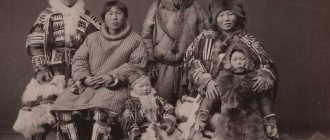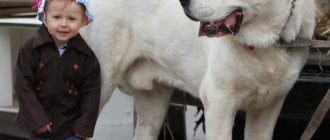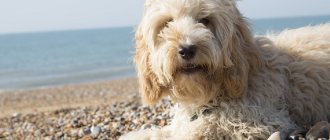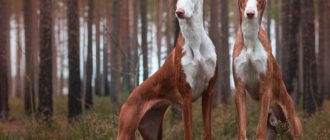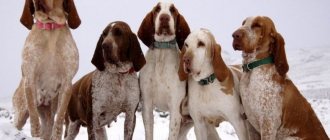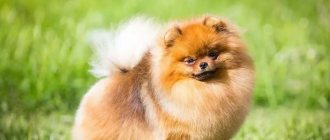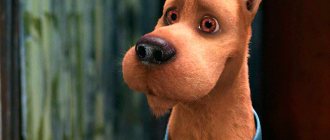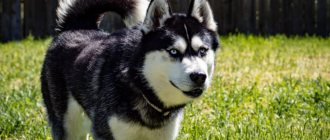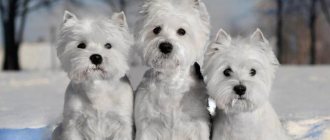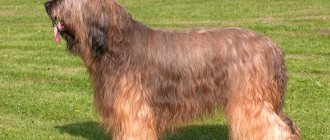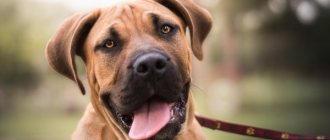Alopekis is a dog breed not recognized by any organization in the world, the history of which has its roots in Ancient Greece. Despite the lack of a breed standard, there are certain characteristics that distinguish pets of this breed from others.
- 2 Breed standard
2.1 Character of the Greek fox dog
- 4.1 What to look for when choosing a puppy
- 5.1 What to feed your Greek pet
- 6.1 Video: briefly about the Alopekis breed
History of the origin of the breed
A rare European breed of Greek origin, the Alopekis dates back to the Bronze Age: similar animals were depicted on ancient amphorae (Neolithic finds, 3000 century BC). It is believed that terriers and spitz dogs originated from them. The name comes from the word “alepou” - “fox”. Alopekis, known as the "little fox", has a fox-like appearance.
Together with meliteo kinidio, they led in number in the cities and villages of Greece until the eighties of the 20th century. Later, dogs of other breeds began to be imported into the country and the popularity of native breeds fell; their uncontrolled crossing began. The sterilization of non-breeding animals added to the troubles of the breed, and as a result, the number of Alopekis in Greece fell sharply.
The purity of the breed was also lost. In 2013, only 58 purebred Alopekis were registered at the Thessaloniki Zootechnia Conference. Now they are considered endangered, so even the Greek Kennel Club does not officially register them.
Purpose
Alopekises combine hunting, guarding and herding talents. Their appearance and behavior are typical of primitive breeds. Everywhere in Greece they were used to exterminate rats and other small rodents, protected poultry from foxes, and interacted well with large shepherd wolfhounds that guarded livestock on the farm and in the pasture. In the north of the country, until recently, they accompanied buffalo to graze. In all regions they are still used to graze goats, sheep and cattle.
Description of the breed
The Ancient Alopekis is a primitive breed, in other words, it can be confused with a mongrel. The height of these small dogs (island dwarfism) is only up to 30 cm, they have developed muscles and an elongated, strong body. At the same time, it is quite light: an adult male reaches only 8 kg.
As an unrecognized breed, the Shorthaired Alopekis has only a preliminary standard - a draft, according to which the following characteristics will be fixed.
Head:
- spitz-shaped or “fox-like”, but wide, with a furrow in the middle;
- the muzzle is wedge-shaped, equal in length to the skull;
- lips tightly fitting, jaws strong, scissor bite;
- eyes are large, dark, with dark eyelids, almond-shaped (heterochromia, blue and yellow eyes are unacceptable);
- the ears are mobile, large, triangular, erect (sometimes semi-dropping).
Torso:
- proportional, muscular, slightly elongated (the ratio of the dog’s height to body length is 4:5 - 4:5.5)
- legs of medium length, strong, oval paw prints;
- the tail is usually carried high, but not carried over the back.
Wool:
- smooth, with undercoat, no longer than 5 cm;
- color: white, black and brown monocolors, as well as their combinations, of which the black-red-white tricolor is the most common,
- there may be several spots; albinism is unacceptable;
- soft, thin or sparse wool is a defect.
These are the requirements recorded in the draft breed standard.
In fact, in Greece, all similar animals with short, medium and semi-long hair (small Greek dog), even moderately shaggy ones, with a “beard” and “mustache” are now called alopekis.
Appearance of Alopekis
Despite their small size, Alopekises have a well-developed body and paws. Their shaggy tail is usually curled upward. Also large ears, although there are dogs with semi-dropping ears. Traditionally, the coat is smooth, short or semi-long, with the exception of being hard. Alopekis with long hair is classified as a related breed of small Greek dogs. “Little foxes” come in different colors, but none of them are albinos. The lightest option is when white is present as the main tone. These dogs are notable for their
Character and behavioral characteristics
Alopekis, as a breed with ancient roots, has no specialization: it is a watchman, a shepherd, and a hunter. Universal dog. This determines his character - active, non-aggressive, curious, reliable assistant, playful companion, devoted to his owner. Gets along well with pets and children. A dog is a bad neighbor only for rodents, both wild and domestic: it will never make friends with a tame hamster.
A stranger or animal makes her wary, but also a desire to get to know each other. He barks little, but given his size he is quite strong and confident - he can call for help, protect his owner or child. Despite his small stature, he is an excellent shepherd. It is better not to leave Alopekis with children unattended: he may inadvertently push them. These dogs do not tolerate idleness, long-term restrictions on personal freedom and ignoring their needs - they will definitely show cunning and intelligence.
Walk
To meet its natural needs, the dog is walked twice a day. The dog does not need frequent long walks. Nevertheless, it will be a pleasure to accompany the owner on nature hikes or just on a joint walk in the park. In the cold season, it needs clothing, since the undercoat is weakly expressed, and in severe frost the alopekis will freeze.
Education and training
They are very smart and try to please people. Training and raising Alopekises is simple: they are not capricious, they have no waywardness. Thanks to the dog’s perseverance and diligence, you can teach it a lot of commands and techniques. For them - any type of dog sport, guarding, herding. He is an average hunter, but he can find and bring game. But it catches rats and mice perfectly.
Activity and cheerfulness remain at a high level until old age. When taking a puppy into your home, decide in advance what you want to make of it. The best way to develop the necessary skills is if you start working with your Alopekis from an early age. If the breed is taken from the street, you will have to overcome some stubbornness during the training process, but this is extinguished by consistent, patient and fair training.
Breeding Tips
If you decide to get a Greek Shepherd, here are a few small tips to consider.
- This dog should not be kept in an apartment, near children - it is an excellent watchdog, but its high level of aggressiveness makes it dangerous.
- To improve protective qualities (hearing, sensitivity), puppies usually have one ear cropped.
- It is always better to take small puppies rather than adult dogs - this is also true for Greek dogs. If you can train your puppy correctly, you will not have a more loyal guard.
- Never take it out on a dog - Greek women are vindictive and hot-tempered; it is better to adhere to good-natured severity in education. It’s also not worth pampering; after all, this is a future watchman.
- Provide your pet with the opportunity for active movement - games with a stick or a tin plate are perfect for the development of a small shepherd dog.
- Consult your veterinarian about your puppy’s diet - for harmonious development, he must receive all the biologically active substances he needs along with food. The ideal option is holistic foods, but they are quite scarce and expensive, so discuss alternatives with a specialist. As mentioned above, Greek dogs are unpretentious, but still, health problems in dogs often begin due to poor nutrition.
We recommend reading: Royal Canin Gastro Intestinal for indigestion
Diseases and care
A primitive breed on which man has not “worked,” Alopekis is not burdened with genetic diseases. These dogs rarely suffer from common internal diseases and have strong immunity. This is essential for street maintenance. They live on average 12 - 15 years.
The skin protects the dog from heat and cold, but does not get dirty easily. Therefore, brushing once a week and occasional bathing is all that the shorthaired Alopekis coat needs to care for. Don't forget to use dog shampoo. Semi-long-haired dogs take a little more time (twice a week) and effort to brush.
Ear cleaning and nail trimming - if necessary. Alopekises themselves take care of their cleanliness: you will hardly find ectoparasites on them, and caring for their appearance will not require much effort from you.
Health
Alopekis dogs are distinguished by good health. There are no genetic diseases due to the fact that the breed has not been subjected to human selection activities and has retained its historical primitive appearance.
Diseases
No serious illnesses are noted. The pet lives 15-17 years without burdening the owner with trips to the veterinarian.
Attention! In the spring-summer season, your pet is treated against ticks!
Vaccinations
It is recommended to carry out routine preventive vaccinations against plague and rabies. Not a single animal is immune from these infections.
Feeding
Alopekises are not prone to overeating and do not require special feeding; street animals are able to survive even near garbage dumps. You just need to follow the general rules for feeding dogs. An adult dog should be fed twice a day at the same time.
Base her diet on meat (~ 50%) and offal (1 - 2 times a week), porridge, and vegetables. Beef, veal, poultry and horse meat are suitable for alopekis. Give the meat raw, and do not forget to deworm the dog every four to six months, before mating and a week before vaccination. Once a week, replace meat with fish (perch, pike perch, pollock or trout), always boiled and clean. Do not give your alopekis bones or “human” food.
What absolutely cannot be done
- It is forbidden to feed your dog exclusively bones and meat.
- Indulging in vitamin supplements including calcium and vitamin D and A will lead to bone abnormalities and may contribute to volvulus.
- A young individual should eat food consisting of 30% protein. If this ratio is violated to a greater or lesser extent, the immune system will weaken and harm will occur to the skeleton and muscles.
- Don't overfeed. Both a young puppy and an adult need optimal balanced food, which the owner will give in small portions. Complementary feeding will contribute to improper growth and development, affect skeletal strength, add weight and increase the risk of disease.
- Irregular feeding is prohibited. From the first days you need to try to accustom your alopekis to eating at a certain time. You need to make it a rule to feed a puppy or an adult in the morning at 8:00, at 14:00 in the afternoon and at 19:00 in the evening.
- Immediately after purchasing a puppy, you should not suddenly change its diet. Check with the breeder from whom the puppy was purchased. He should give advice and recommendations on choosing food.
- It is necessary to gradually transfer the dog to another type of food. It is safest to change your usual routine after 5-6 months of life. Then the puppy is already more receptive to different types of food, his intestines and stomach are practically formed.
- Make sure that the food completely disappears from the bowl. If the puppy does not eat enough, which is expressed by licking the bowl for a long time and standing near it even after the food has ended, do not change your rules and do not add supplements. You can't teach people to beg. If desired, you can increase the portion at the next feeding.
Price and where to buy a puppy
You will not find a breed club or kennel either in Russia or even in Greece, so it makes sense to look for a “purebred” puppy only through the Greek Community for the Rescue and Revival of the Breed or with the help of members of Alopekis fan communities on Facebook and special forums.
If you have the opportunity to travel to Greece, you can personally look there for a dog with a similar appearance and character. Of course, in this case you will not have a guarantee that the puppies will be purebred.
In order to preserve and spread the original Greek dog breed, the Alopekis rescue community most often gives puppies to those who want them free of charge or very inexpensively, but nothing is known about sales to other countries.
Nurseries
There are no official alopekis nurseries engaged in breeding. You can try looking for a puppy on the Internet. But there is no guarantee that you will get a representative of this breed. Before purchasing, it is advisable to invite a person who knows about dogs. It will help you determine what kind of puppy you are offered to buy.
It's a shame that small Greek dogs are deprived of people's attention. After all, behind the unpresentable appearance hides a sensitive nature, a loving soul, a loyal friend. Natural kindness and non-conflict character make Alopekis a family favorite.
Owner reviews
Victoria K.
“People often tell me that my alopekis is the spitting image of a mongrel. I generally agree. But you should have seen how smart and obedient he is! All my doubts about my appearance disappeared when I saw how Toshka was quickly learning all the commands that you could think of.”
Georgy V.
“He eats absolutely everything I give, and at the same time he is healthy. He eats absolutely anything, and if he overdoes it, he dumps excess energy on the very next walk, you can’t stop it. It's like he feels it. My alopeshka is already old, about 10 years old, but not obese, and rushes like a hurricane around the site during walks.”
Alexandra P.
“My Jessie has unique ears: one floppy and one standing. And she is also very affectionate. I come home, and she doesn’t even bark, but squeals like a child with joy and jumps. And at these moments even her drooping ear goes up.”
Maltese (Maltese) – 3-4 kg
Such a dog can be seen among popular show business stars. It is considered sophisticated, imparting aristocracy to the owner.
The first thing that catches your eye is the thick, snow-white fur that hangs down to the floor. The amazing thing is that their coat never gets tangled and always remains clean and well-groomed (this breed is very clean). Their wool is also very soft to the touch, comparable to silk.
As for their character, they are very active and curious dogs. They can often run away from their owner in search of adventure. But don’t worry about the curious baby: despite their small height and weight, they can fend for themselves.
It should be noted the special magic of the Maltese eyes. These small, slightly protruding eyes can charm even the most stable person. One look into these gorgeous eyes after a hard day at work is enough to recharge with positive energy and start enjoying life again.
Similar breeds
Body type: European Spitz, Terrier, Lancashire Heeler, Lapphund.
By height: Beagle, Yorkshire Terrier, Small Poodle, Dachshund, Pug, Schipperke, Manchester Terrier, Sussex Spaniel, Brussels Griffon, Papillon.
By coat length (short-haired): Labrador retriever, beagle, pug, Jack Russell terrier, Brazilian terrier.
By character and working qualities: Labrador, Spitz, Beagle, Dachshund, Shepherd.
By ease of training: Labrador Retriever, Golden Retriever, German Shepherd, Australian Cattle Dog, Welsh Springer Terrier, Sheltie, Beauceron.
No. 1. Chihuahua
Top 10 smallest dog breeds in the world. Chihuahua.
So, the leader among small dog breeds is the Chihuahua. Charming kids come from Mexico. All over the world they are recognized by their small size, large ears, button eyes and loud bark. The weight of a Chihuahua does not exceed 2.7 kg, and its maximum height is 12.7 cm. The life expectancy is quite long - from 12 to 20 years. Many celebrities choose these little ones for themselves, as they can be easily taken with them on tour.
By the way, today the smallest dog in the world is a representative of this particular breed. The record holder's name is Millie, her height was recorded at 9.65 cm, and her weight was 450 grams. The owner of the baby says that the puppy was born so tiny that it could easily fit into a teaspoon. By the way, before Millie there was another dog of the same breed in this category. The nickname of the previous winner is Boo Boo, her height is 10.16 cm.
And even though dogs of this breed are miniature, they can be good guards. There is no need to perceive this animal as a pet toy for children. This is not a dog, but a mini-warrior who will not tolerate insults from children. He will start to defend himself and may even bite. However, such unpleasant consequences can be avoided with proper education, a reverent and gentle attitude from puppyhood.
Briefly about the main thing
- This is the oldest European breed (type of dog) of Greek origin.
- Outwardly primitive, ordinary, but have a wonderful disposition.
- Thanks to natural selection, Alopekises are very healthy dogs with high immunity.
- They reproduce slowly due to small litters and high mortality of puppies.
Are you looking for a loyal dog friend? Write to us, did this article help you make a choice?
Did you like the article? Share it with your friends on social media. networks. This will help them get useful information and support our project.
Belgian Shepherd
A classic dog breed used by police officers. The Belgian Shepherd is smart, fast, agile and brave
It has excellent sense organs and a number of advantages, including: caution, excellent observation, endurance, courage and courage. Used by police for many types of work: search, rescue, special purpose work
He is very trainable and has good physical characteristics. However, such amazing performance of the dog did not become known immediately. Initially, he was bred as a shepherd. The “Belgian” will cope with any task 100%, because he knows that the owner relies on him, and therefore will not let him down. There are 4 types of Belgian Shepherds:
- Malinois.
- Tervuren.
- Groenendael.
- Laekenois.
Regardless of the variety, the dog adores its owners and always strives to accompany them. Gets along with children and pets. Toddlers may be frightened by the loud barking that will likely be produced during play. In this case, the dog will be guided by the herding instinct
She makes sounds to attract the attention of the herd or children
Temperament
The Alopekis pet is a true friend, devoted to its owner. This dog is capable of making friends with others. Representatives of the breed are not prone to aggression, they are active, curious and friendly. Alopekis would never harm a child. The pet gets along well with various pets, with the exception of rodents.
Since representatives of the breed have long lived on the streets, they are distinguished by cunning, intelligence and ingenuity, which helped them adapt to difficult conditions. Alopekises show courage, vigilance and quick reaction in various situations. They have endurance and patience.
The most important advantage of Alopekis is their attachment to their owner and the desire to please him. In addition, they are not fussy in care and maintenance, they get used to any environment.
Pets of this breed are well trained and obedient. The process of training them is not difficult, since they are not prone to being overly stubborn during training.
Another positive characteristic of Alopekis is the absence of loud and frequent barking, so you can safely have a pet of this breed in a city apartment without fear of causing inconvenience to others.
Black Pied Piper - Affenpinscher
The Affenpinscher (German: Affenpinscher monkey pinscher) is a dwarf pinscher, up to 30-35 cm high, which was originally created for hunting rats in houses, barns and shops. I received benefits from them and know. Gradually, they turned from hunters into companions of rich ladies. This is a friendly, mischievous companion dog.
Dogs of the German Affenpinscher breed were first known from the beginning of the 16th century, but they were larger (30-35 cm) and had a variety of colors: gray, black, even red. Often there were white socks on the paws and a white shirt front on the chest.
These were rat-catching dogs who lived on the farm and slept in the stables, their task was to strangle rats. Judging by historical materials, Affenpinschers were first bred as a breed in Lübeck (Germany). They were used on farms, in homes, and by the rich. The name itself comes from the German word Affe - monkey and the name translates as monkey pinscher.
In the paintings of those times you can see small dogs with hard hair - these are the ancestors of today's dogs. But it is difficult to establish the exact origin; they became the ancestors of other breeds - the miniature schnauzer and the Belgian griffon. The relationship between them is easy to discern even now, just look at the coarse fur and the muzzle with a beard.
Affenpinschers weigh from 30 to 6 kg, at the withers they reach 23-30 cm. Their coat is coarse and hard, but if it is cut short, it becomes softer and fluffier. The undercoat is soft and lies in waves. On the head, the hair forms a mustache and beard, which gives the muzzle a warlike expression, reminiscent of a monkey.
The hair on the head and shoulders is longer and forms a mane. The Fédération Canine Internationale and Kennel Club standard allows only black Affenpinschers, but the American Kennel Club allows gray, brown, black and white, and multi-colored colors. Other clubs have their own preferences, but black is still better.
The Affenpinscher is a happy combination of charm and courage. A small dog with endurance, courage, but on occasion showing sensitivity and tenderness. They learn unusually quickly, so that outside observers can only be amazed at their intelligence.
Future owners need to remember that this is a big dog in a small body. Their fearlessness may provoke attacks from the large dogs they charge at, but it gives them a charm.
The advantages are that they are easy to travel with, they easily adapt to changes and require minimal grooming. They are always on the alert and ready to protect the owner, his home and property.
They take themselves seriously, and coupled with their intelligence, they get a small, serious protector.
Affenpinschers are often compared to terriers, and they are close, although different from each other. They are active, enterprising, curious, and stubborn, but they are cheerful and playful, lively, affectionate towards family members, and protective of them. This little dog is loyal and loves to be with his family.
She needs consistent, firm training, some will be destructive to the apartment. They can be territorial when it comes to food and toys, so they are not recommended for families with small children. They don’t like being squeezed or chased, and this is difficult to explain to a small child.
